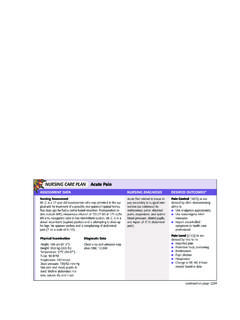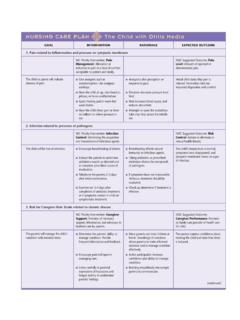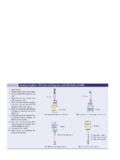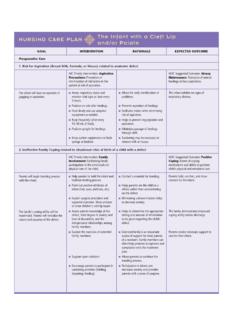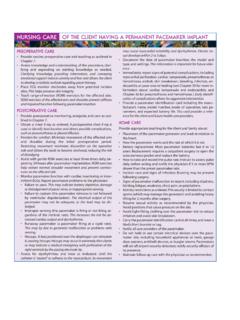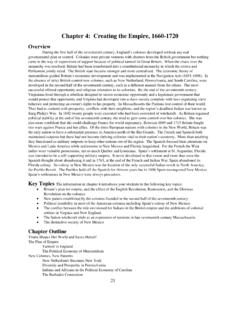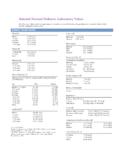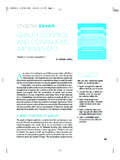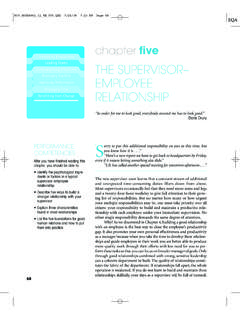Transcription of Nursing Care Plan A Client with Myasthenia Gravis
1 CHAPTER 43 / Nursing Care of clients with Neurologic Disorders 1435. ineffective airway clearance and impaired swallowing; other Dysphagic clients are at risk for aspiration; matching food Nursing diagnoses that commonly apply, such as that related to consistency to the Client 's ability to swallow enhances fatigue, are addressed in other sections of this chapter. safety. Plan meals to promote medication effectiveness. Pyrid- Ineffective Airway Clearance ostigmine should be given 30 minutes before the meal to pro- The underlying causes for ineffective airway clearance for the vide optimal muscle strength for swallowing and chewing. person with Myasthenia Gravis include poor cough mechanism, Have the Client eat slowly, using small bites of food. decreased rib cage expansion, diminished diaphragm move- Schedule meals during periods when the Client is adequately ment, and decreased expiratory effort.
2 The following interven- rested; develop a daily schedule incorporating rest periods. tions require particular attention if the Client undergoes a Fatigue may add to dysphagia, putting the Client at greater thymectomy. risk for aspiration. Assist with turning, deep breathing, and coughing at least If necessary, give cues while eating, such as: Chew your every 2 hours. Teach proper coughing techniques; use an in- food thoroughly; swallow. Keeping Client focused may en- centive spirometer every 2 hours while the Client is awake. hance swallowing. Position changes promote lung expansion; coughing helps Teach caregivers the Heimlich maneuver and how to suction. clear secretions from the tracheobronchial tree. Knowing specific measures to take in case of aspiration de- Place in a semi-Fowler's position. This position expands the creases both the Client 's and family's anxiety and promotes lungs and alleviates pressure from the diaphragm, especially confidence in managing potential problems.
3 Important considerations if the Client is obese. Maintain hydration status and monitor for dehydration; use a Home Care humidifier as needed. If needed, teach family how to perform Teaching for the Client and family with Myasthenia Gravis percussion, postural drainage, and suction. Interventions to focuses on prevention and recognition of crisis situations, un- liquefy secretions, such as ensuring a daily fluid intake of up derstanding the disorder, and methods for coping with both to 2500 mL (perhaps via feeding tube or parenteral route), physical and psychosocial problems. Setting realistic goals help the Client mobilize and expectorate sputum. with the Client and family provides opportunities for self- Assess lung sounds, the rate and character of respirations, assessment and promotes active participation in rehabilitation. and pulse oximetry readings at least every 4 hours or as in- Address the following topics.
4 Dicated by Client 's condition. Monitoring for hypoxia and worsening of Client 's ability to move air alerts the nurse to The importance of maintaining consistency in medication early signs of arteriovenous shunting. dosage and management Realistic expectations Impaired Swallowing Methods to avoid fatigue and undue stress; specific measures clients with Myasthenia Gravis have weakness of the laryngeal for avoiding upper respiratory infections and exposure to and pharyngeal muscles involved with swallowing. Alterations extreme heat or cold in swallowing place the Client at risk for poor nutrition as well Birth control measures or referral for counseling (Pregnancy as for possible aspiration. Family members need to be included can exacerbate symptoms; also, medications used to control in teaching, particularly the person who prepares and assists Myasthenia Gravis , such as neostigmine bromide with meals.)
5 (Prostigmin), cross the placenta.). Assess the ability to safely manage various consistencies Referral to support groups of foods; consult with a speech pathologist for evaluation. Helpful resources such as the Myasthenia Foundation Nursing Care Plan A Client with Myasthenia Gravis Kirsten Avis,a 44-year-old homemaker and mother of two teenage eral ptosis, and mild dysphagia in the late sons, was diagnosed with Myasthenia Gravis 2 years takes afternoon and evenings. an anticholinesterase medication,pyridostigmine (Mestinon),four times a day. Over the past month she has been experimenting ASSESSMENT. with decreasing the dose of her pyridostigmine because she has Lela Silva, RN, is caring for Mrs. Avis. Physical examination of felt so good. She was prescribed 60 mg of pyridostigmine three Mrs. Avis reveals severe muscle weakness bilaterally in her hands, times a day before meals and one-half of a long-acting 180 mg arms, and thorax.
6 Her voice is nasal, and she speaks slowly; the pyridostigmine tablet at night. longer she speaks, the more difficult it becomes to understand Three days ago, she began having chills and fever and her her. She is anxious and dyspneic. Her complaints of weakness, dys- myasthenic symptoms became markedly worse. Mrs. Avis is easily phagia, dysarthria, problems with mobility, and ptosis are more fatigued and has been experiencing increasing weakness, bilat- (continued). 1436 UNIT XII / Responses to Altered Neurologic Function Nursing Care Plan A Client with Myasthenia Gravis (continued). pronounced later in the day. Vital signs are as discuss the need to wear MedicAlert identification and review follows: BP 138/88, P 88, R 28, T F (39 C). medication administration techniques with Mrs. Avis. The nurses Some improvement in muscle weakness is noted following a emphasize in particular that Mrs. Avis must not split time-released restful night's sleep; however, the respiratory distress is more medications.
7 Evident, and Mrs. Avis is increasingly restless. She is moved to the Within 5 days, Mrs. Avis's condition stabilizes, and her weak- intensive care unit for advanced monitoring and possible ventila- ness decreases sufficiently to allow discharge home. Although tory medical diagnosis is myasthenic crisis second- her temperature has returned to normal and her respiratory sta- ary to pulmonary infection. tus has improved, she still has a productive cough. Oral antibi- otics are prescribed for 2 weeks, after which she will have a DIAGNOSES. follow-up visit with her primary care provider. She is instructed Impaired gas exchange, related to ineffective breathing pattern to seek treatment promptly if respiratory symptoms or temper- and muscle weakness ature indicate recurrence of infection. Risk for aspiration, related to difficulty swallowing Fatigue, related to increased energy needs from muscular EVALUATION.
8 Involvement Mrs. Avis is discharged without developing aspiration pneumo- nia or any symptoms of aspiration. Her airway was maintained EXPECTED OUTCOMES. throughout the myasthenic crisis, and her pulse oximetry read- Pulse oximetry readings will be maintained at 92% or above. ings remained above 92% once oxygen therapy was initiated. On No aspiration will occur. discharge, pulse oximetry is above 95% without oxygen therapy. Will verbalize decreasing fatigue when performing ADLs. Mrs. Avis states that her fatigue and weakness have significantly Will state the correct method of medication dosing and improved. demonstrate how she will maintain schedule. Both Mrs. Avis and her husband are able to explain the differ- PLANNING AND IMPLEMENTATION ence between myasthenic and cholinergic crises and to identify Mrs. Avis's manifestations improve following administration of methods to avoid both problems.
9 Mrs. Avis correctly relates her edrophonium chloride (Tensilon) to verify myasthenic crisis. She proper medication regimen and makes an appointment for a is placed on oxygen by mask and suctioned as needed; equip- follow-up visit with her physician. ment for possible intubation and ventilation is made readily Critical Thinking in the Nursing Process available. She is placed in a semi-Fowler's position, and vital signs are assessed every 5 minutes during the acute 1. What is the rationale for administering Tensilon to evaluate a nurses in the intensive care unit remain in constant attendance myasthenic crisis? throughout the crisis period and provide explanations to Mrs. 2. Develop a plan to teach Mrs. Avis how to avoid fatigue when Avis in an effort to decrease her stress and to avoid further sever- preparing and eating meals. ity of manifestations. 3. Develop a Nursing care plan for Mrs. Avis for the Nursing Three days after the crisis period, Mrs.
10 Avis is moved to a pro- diagnosis, Ineffective role performance. gressive Nursing care unit. Nurses follow up on teaching her the See Evaluating Your Response in Appendix C. manifestations of both myasthenic and cholinergic crises. They THE Client with viral or bacterial infection 1 to 3 weeks prior to the onset of GUILLAIN-BARR SYNDROME manifestations, surgery, viral immunizations, and other viral illnesses. In 60% of cases, Campylobacter jejuni is identified as the cause of the preceding infection. Approximately 80% to Guillain-Barr syndrome (GBS) is an acute inflammatory 90% of clients with GBS have a spontaneous recovery with lit- demyelinating disorder of the peripheral nervous system char- tle or no residual disabilities. However, the disease has a 4%. acterized by an acute onset of motor paralysis (usually ascend- to 6% mortality rate, and up to 10% of cases have permanent ing). The classification of Guillain-Barr subtypes includes disabling weakness, imbalance, and sensory loss (McCance &.)
